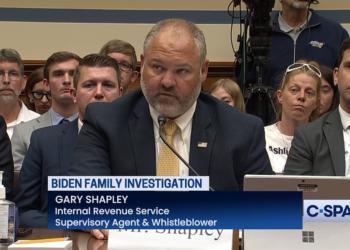The stock market fell significantly on Thursday after President Donald Trump‘s “Liberation Day” announcement.
Trump began his “Liberation Day” announcement after 4 p.m. on Wednesday, when markets closed for the day, meaning the main impact of the announcement in the United States only occurred after markets opened at 9:30 a.m. The announcement already had an effect on futures, however. Futures for the S&P 500 declined 3.4% before opening, the Dow Jones Industrial Average by 2.8%, and the Nasdaq by 3.8%.
Upon opening, the Dow was down 1,150 points, the S&P 500 by 3.14%, and the Nasdaq by 4.13%.
Big U.S. stocks tumbled. Nike fell 10.64%, Apple fell 7.95%, and Amazon fell 6.83%.
Global markets were sent reeling. Japan’s benchmark Nikkei 225 index fell over 4% after the open, South Korea’s Kospi index fell 2.7%, Europe’s benchmark Stoxx 600 fell 1.2%, Germany’s DAX index fell 1.3%, France’s CAC fell 1.6%, and London’s FTSE 100 fell 1%.
Sony fell 5.4% in the morning, Toyota fell 5%, Honda fell 4%, Samsung fell 3%, and Hyundai fell 3%.
The dollar faced significant pressure as traders began losing confidence in the world’s primary reserve currency. The dollar index, measuring the U.S. dollar against six others, fell 1.78% to its lowest point since early October at $101.65. The Euro, Japanese Yen, and the British Pound all rose significantly. The Euro made out the best, gaining 1.5% to a six-month high of $1.1021.
The Deutsche Bank Research said the “dramatic nature” of the moves left it “increasingly concerned that the dollar is at risk of a broader confidence crisis,” Seeking Alpha reported.
“The safe haven properties of the dollar are being eroded and this is imposing a significant cost on unhedged dollar holdings. Beyond that, developments since the start of the year make us worried about a broader undermining of confidence in the U.S. economic outlook and the medium-term desirability of dollar allocations,” the Bank said.
After earlier rising to an all-time high, the price of gold retreated 1.4% to $3,090. U.S. gold futures sank 1.7% to $3.111.40. Spot silver fell 4.7% to $32.44, while Platinum declined 2.6% to $957.60, and palladium declined 1.6% to $954.78.
Despite the dip, Adrian Ash, director of research at BullionVault, said the long-term prospects for gold are still at a record high, according to Reuters.
“Weaker trade, higher input costs and shrinking margins are badly hurting the stock market, while geopolitical mistrust is deepening,” he said
“Such a gloomy outlook for economic growth offers the perfect backdrop for further gains in gold,” Ash added.
Cryptocurrency also faced a significant fall. Crypto exchange Coinbase Global fell roughly 4% and bitcoin holder Strategy dropped 3%.
Sal Guatieri and Jennifer Lee, senior economists with BMO Capital Markets Economics, said the fall is the result of fears of an increasing trade war.
“Most commodity prices are lower, even gold, on concern that this major escalation of the trade war will harm not just the global economy but the U.S. as well,” they said, according to WFMZ.
Trump announced “Liberation Day” in a Rose Garden speech attended by autoworkers, Cabinet members, and members of Congress. In his speech, holding a chart showing different tariff rates, he accused foreign countries of taking advantage of the U.S. through unfair trade policies and said April 2 marked the U.S.’s “declaration of economic independence.”
“For decades, our country has been looted, pillaged, raped, and plundered by nations near and far, both friend and foe alike,” Trump said, pointing to the loss of U.S. factories and the outsourcing manufacturing jobs.
“With today’s action, we are finally going to be able to make America great again – greater than ever before,” he added. “Jobs in factories will come roaring back into our country.”
Every country was slapped with a 10% base tariff, with additional “reciprocal” tariffs slapped on others. China was hit with a 34% tariff, in addition to a previous 20% tariff, bringing the total to 54%. Cambodia (49%), Laos (48%), and Vietnam (46%) were among the hardest hit with “discounted” reciprocal tariffs. The United Kingdom and Australia were among the countries to get hit with the minimum 10% tariff. Notably, Israel wasn’t spared from a higher tariff rate, being hit with a 17% tariff.














